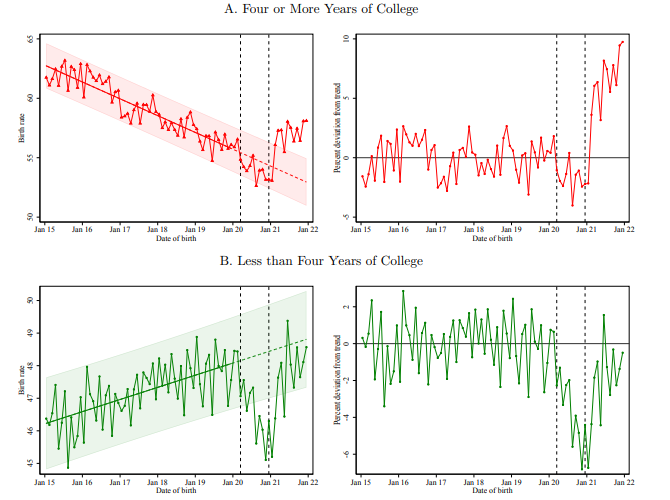National Bureau of Economic Research has just released some fascinating research on US fertility rates (Covid-19 Baby Bump - thanks to my subscribers for pointing it out). There are lots of interesting things in the research. First of all, I am massively surprised by the number of US births by mothers that do not actually live in the United States. It has been well known that mother’s that were not born in the US (i.e. immigrants) have higher birth rates, but the NBER data shows that when Covid-19 disrupted travel, birth from mother’s not born in the US collapsed more than native born mothers. For a foreign-born mother, living in the US, Covid should not have effected birth rates, but for mothers looking to travel to the US to give birth, this would have naturally stopped this from occurring.
A large part of the drop in births can be put down to the collapse in birth of mothers who were born in China. The birth rate collapsed before other regions due to travel restriction on China, and unlike other regions have yet to recover. California was a popular choice for Chinese women to travel to give birth. Births by foreign mothers in California in 2018 was 163,303 and this fell to 138,972 in 2020. California alone made up 33% of the fall in foreign born mothers. Texas only saw foreign mother births fall by 8,000 over the same period.
So Covid-19 caused births in the US to fall, but only because it stopped some mothers from going to the US to give birth. When we look at fertility rates for just US born women, there is a dip 9 months after Covid-19 hit, but then a bounce back above trend (stuck at home with nothing to do always struck me as perfect conditions for baby making).
In my posts, I have thought there are three policies that governments could adopt to promote fertility rates. First is to give more money to lower earners, second is free childcare, and the third is free IVF. Covid-19 response in the US did the first two of these policies, but not the third. The third policy should boost birth rates for older women, while the first two should boost birth rates for all women, which is what the NBER data shows. All ages groups showed a sizable increase in birth rates although skewed to younger mothers.
The US did not offer free childcare but work from home culture would have benefited childcare conditions for college-educated women, or white-collar workers more than blue- collar workers. Again, the boost in birth rates was concentrated in while-collar workers.
We have shown that Israel and Denmark which have extremely pro-natal policies towards IVF have higher birth rates. And when governments give workers more money, and the ability to care for children, either through childcare or work from home policies, birth rates increase. For government wanting to boost birth rates, the policy choices are clear. Demographics is not destiny, its policy.







